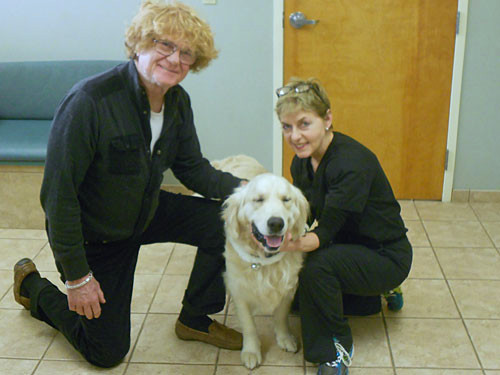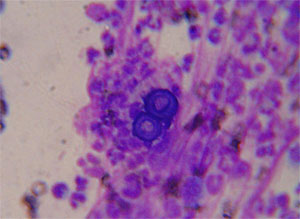 When coming in with an ill pet it is always important to provide Dr. Neumeister with as much information as possible, even if you think it might not be of importance.
When coming in with an ill pet it is always important to provide Dr. Neumeister with as much information as possible, even if you think it might not be of importance.
In one particular case, Dr. Neumeister was able to diagnose Blastomycosis early on after the owners shared that the dog had been playing in the Mississippi River. Based on only the symptoms the dog’s illness could have been mistaken for a lung infection of bacterial origin, cancer, or other diseases.
Due to the additional information, Dr. Neumeister also tested for fungal infections and Blastomycosis was confirmed.
Symptoms
one or more of the following:
- Fever
- Loss of appetite
- Weight loss
- Eye discharge
- Eye inflammation, specifically the iris
- Coughing, wheezing, and other unusual breathing
- Skin lesions
- lameness
- draining skin lesions
- fainting/passing out
What is Blastomycosis?

Photo of a Blastomyces dermatitidis organism taken through a microscope at 1000x magnification. The slide was made from a skin sore on a Great Dane suffering from blastomycosis
Photo of a Blastomyces dermatitidis organism taken through a microscope at 1000x magnification. The slide was made from a skin sore on a Great Dane suffering from blastomycosis
Photo of a Blastomyces dermatitidis organism taken through a microscope at 1000x magnification. The slide was made from a skin sore on a Great Dane suffering from blastomycosis
Blastomycosis is a systematic yeast-like fungal infection caused by a fungus called Blastomyces dermatitidis which lives in moist soil and in association with decomposing organic matter such as wood and leaves.
The infection typically occurs when the dog inhales the airborne fungal spores after the contaminated soil has been disturbed. This can be from an activity as benign as digging in the dirt or following a scent trail. The spores can also enter through the skin.
The fungus thrives in wet environments, such as riverbanks, lakes, and swamps, where damp soil lacking direct sunlight fosters the growth of the fungus. It is also present in areas that are rich in decaying matter, such as wooded areas, forests, and farms. It is a naturally occurring North American fungus, with the highest prevalence of infection taking place in geographic areas located near water – such as the Mississippi, Ohio, Missouri, and Tennessee River basins. It has also been found in the area of the Great lakes and st. Lawrence river, southern Canada, and outside the endemic area in colorado.

photo of Mississippi by Dubuque
Studies have concluded that most affected dogs live within at least 400 meters of a body of water. This is particularly so with large-breed dogs between 2 and 4 years of age weighing at least 55 lbs (25 kg), and especially sporting breeds (sporting breed association may reflect increased exposure rather than susceptibility). It occurs most frequently in male dogs, but female dogs are also susceptible. Exposure to areas with water, decaying matter, or recently excavated areas increases the risk of exposure to the fungus and the consequent development of the disease.
What is happening?
- A small spore (conidia) is shed from the mycelial phase of the organism growing in the soil and inhaled, entering the terminal airway
- At normal body temperature, the spore becomes yeast, which initiates the infection in the lungs and spreads systemically. Although infection almost always begins in the lungs before being disseminated through hematogenous or lymphatic routes to other body tissues, lung lesions occasionally resolve by the time infection in other sites becomes apparent
- From this focus of mycotic pneumonia, the yeast disseminates hematogenously throughout the body
- The immune response to the invading organism produces a pyogranulomatous infiltrate to control the organism
- The result is organ dysfunction
- The severity of lung involvement and invasion into the brain affect the prognosis
- Early diagnosis improves the chance of survival, as 25% of dogs die during the first week of treatment
Humans can get Blastomycosis as well
Blastomycosis does not spread from animals to people, except through bite wounds. Since it is acquired from an environmental source pet owners should be aware that they might have been exposed at the same time their pet did. If these pet owners have respiratory issues or skin lesions they should inform their physicians that they might have been exposed. In humans lung infection can occur after a person inhales the airborne, microscopic fungal spores from the environment; however, many people who inhale the spores do not get sick. Only about half of the people who are infected with blastomycosis will show symptoms. If symptoms occur, they usually appear between 3 and 15 weeks after being exposed to the fungus. The symptoms of blastomycosis are similar to flu symptoms and include fever, chills, cough, muscle aches, joint pain, and chest pain. In very serious cases of blastomycosis, the fungus can disseminate (spread) to other parts of the body, such as the skin and bones.
Sources:
- http://veterinarymedicine.dvm360.com/canine-blastomycosis-review-and-update-diagnosis-and-treatment
- http://www.petmd.com/dog/conditions/respiratory/c_multi_blastomycosis
- http://www.cdc.gov/fungal/diseases/blastomycosis/
- http://commons.wikimedia.org/wiki/File:Blastomycosis_cropped.JPG
- Tilley, L., & Smith, Jr., F. (2011). Blastomycosis. In Blackwell’s five-minute veterinary consult: Canine and Feline (Fifth ed., pp. 174-175). Ames, IA: Wiley-Blackwell.
- Photo of Dubuque Iowa Julien Dubuque Bridge: CC BY 2.0 Dirk – originally posted to Flickr as Dubuque Iowa Julien Dubuque Bridge
